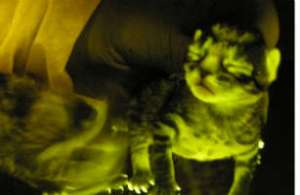A litter of fluorescent kittens is illuminating more than their proud mother’s eyes. These glowing animals have been genetically engineered to make blood cells that are resistant to feline immunodeficiency virus, or FIV, the virus that causes feline AIDS. The study could give researchers insight into fighting AIDS in both humans and cats.
While humans cannot get infected with FIV — and cats don’t get sick from HIV — understanding how the viruses work in different species could lead to better treatments and methods of prevention. HIV, or the human immunodeficiency virus, has already killed 30 million people worldwide, with 33 million currently infected.
“The world is suffering from two huge AIDS pandemics,” says lead author Dr. Eric Poeschla of the Mayo Clinic. “Less well known is the one in cats.”
FIV infects 1% to 3% of cats worldwide, mainly feral cats. The virus affects all species of cats, including lions and tigers. All but domestic cats are endangered species.
“This [research] can help feline health as much as it helps human health,” Poeschla says.
MORE: The Science of Women and Cats: The Bond Is Real
To create the kittens, Poeschla and his colleagues used a rhesus monkey gene that confers resistance to feline AIDS and a gene that allows certain jellyfish to emit an eerie green glow when exposed to ultraviolet light. Both genes were inserted into egg cells obtained from female cats that were being spayed. The eggs were fertilized and then transferred to a surrogate mother cat, similar to the way in vitro fertilization is done in humans using donor eggs.
Both the monkey gene and the jellyfish gene were ferried into egg cells using a virus that does not cause disease. Because the genes were engineered to be expressed together, the scientists could more easily see and study any cell in the resulting kittens in which the FIV-blocking gene was active — those cells would glow. “The genes are encoded within the same gene transfer vector,” says Poeschla. “When it integrates [into the cell], they are together in same little piece of DNA.”
Three kittens, two males and one female, were born. “The kittens are completely normal — frisky, happy, healthy and interactive,” says Poeschla, adding that they seem completely unfazed by their ability to glow.

Courtesy of Mayo Clinic
MORE: Crazy Cat Love: Caused By Parasitic Infection?
The research isn’t the first to produce a glow-in-the-dark kitty, but it is the first to successfully demonstrate that viruses can be used to insert FIV-blocking genes into the eggs of carnivores. In this case, the researchers worked with a monkey gene that encodes a virus-fighting protein called TRIMcyp.
“The reason to look at cats is that they’re the only mammals besides us and chimpanzees that have a naturally acquired AIDS virus,” explains Poeschla. (Incidentally, the scientists who developed the technique to use jellyfish proteins to study gene expression won the Nobel Prize in chemistry in 2008.)
The next step will be to see if the gene makes cats completely resistant to FIV. Right now only the animals’ blood cells have been tested for resistance.
The new research was published in the journal Nature Methods.
MORE: Study: Fast-Moving Cartoons Like SpongeBob May Impair Kids’ Focus
Maia Szalavitz is a health writer at TIME.com. Find her on Twitter at @maiasz. You can also continue the discussion on TIME Healthland’s Facebook page and on Twitter at @TIMEHealthland.

